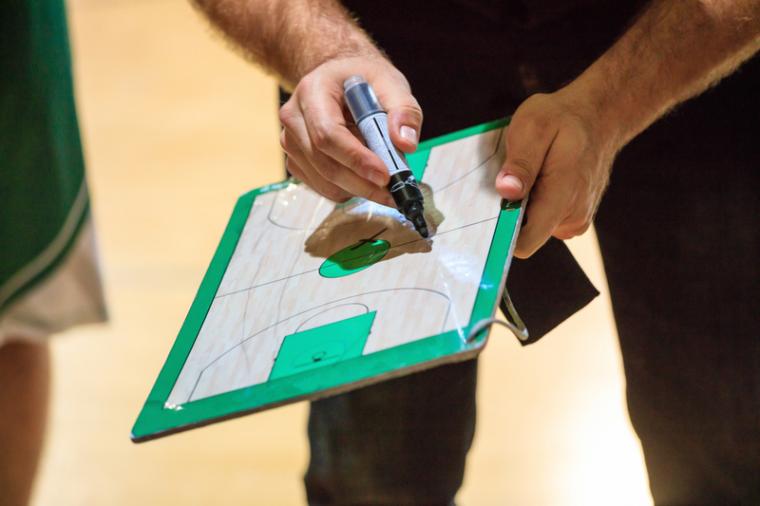
One of the new Olympic disciplines, 3x3 basketball (where the U.S. Women’s National Team won gold), emerged as the breakout star among TV viewers. It’s fast-paced, takes up less court space, has its roots in the urban game, has multiple sponsored tours – and people tuned in to watch it in the Games.
(Editorial note: It’s pronounced “three-ex-three,” not three-by-three, three-on-three, three-times-three or any other permutation). From an organizational perspective, 3x3 is easy to implement. It takes a half-court, one net and six players total. (In formal competition, each team has four players, three of whom are on the court, and one alternate). Each game is capped at 10 minutes and the first team to reach 21 points wins, making it easy – and less time-consuming – to watch.
Jay Demings, USA Basketball Youth & Sport Development Director, sat down with SDM to explain the organization’s efforts to grow the discipline.
History of 3x3 in the USA
3x3 was formalized by FIBA in 2010. That was the year it was included as a discipline in the Youth Olympic Games. We sent a team, but we didn’t do very well. Now, a decade later, it is starting to catch on.
Outside of the states, 3x3 has a bigger following, particularly in the Asian countries, although it is big in Europe too. There are strong teams in Latvia, Serbia, Belgium and the Netherlands – Mongolia too – in fact, a lot of places you wouldn’t think of traditional powerhouses are investing in the sport.
You’d think it would be bigger in the United States; you could argue that we have primarily used 3x3 as a training tool for years. It has similar benefits to what you have seen in 5-on-5 soccer or 6-on-6 lacrosse – getting more touches on the ball, for example.
The Travel Tournament Market
Private tournament operators have struggled to figure out how to promote 3x3 as its own discipline and still make money. For example, if you are charging X as a registration fee for one team that has 12 players, you can divide that registration fee among all 12 of those players. In 3x3, you’re dividing the fee among four players at the most, so it costs more and it’s a tougher sell.
We find ourselves operating a lot of the national 3x3 tournaments; for us, it’s not as much about making money as it is about the development of the discipline. I would say that we’ll see growth less in the travel team market and more in the high school and middle school levels. We’re also hoping for growth in the parks and recreation area since there are a lot of courts there. Kids get enamored of what they see on TV, and they want to try it. We’re in the process of developing a toolkit that will help schools and other organizations start programs and leagues.
One 3x3 tournament we have held successfully has been for collegiate players who have completed their eligibility and finished their season. Up until now, we have only held a men’s division, but I think in light of the success of the USWNT, we will be looking to add a women’s division.
We’ve also seen a lot of 3x3 played at the club and recreational sports level in college. It’s still growing there. In fact, the club version has preexisted the formal version – we tapped into the college intramural programs, and we’ve seen that it’s still growing there. We’re hoping to pick this up and run with it.
The Outdoor Game
3x3 was designed to be an outdoor game but of course in the U.S., where the climate is so varied, basketball has traditionally been played indoors. I can see 3x3 taking off indoors; there are a lot of really good indoor facilities in this country. But the 3x3 game is made for the outdoors overall.
I see 3x3 basketball as being what beach volleyball is to indoor volleyball; it has that vibe. That and the nature of the shortened game makes it very digestible for fans. In the formal 3x3 competitions we host, there is music that is played throughout the game, either by a DJ or on a sound system; that’s not something you see in the traditional game of basketball. 3x3 has an entertainment aspect that draws people in. It’s easy to imagine a weekend tournament that brings in a lot of teams.
Over the last few years, we have tried to put 3x3 into areas with some natural traffic – street festivals, activities held around Final Four, games that are held in a mall – if you find places where people are passing by, and they know it’s a short game, they’ll sit and watch it. So, in some ways, it’s just a case of trying to find places that it can grow.
The Olympics Will Help Visibility
The Olympics made the TV viewing public aware of 3x3. The fact that the USWNT won the gold is even better because it teaches kids that playing this discipline of the sport can really lead somewhere. The men’s national team didn’t qualify but that also puts attention on an important point: It’s not the case that we’re always going to be in it, or that we’re going to win if we are.
I think as the sport continues to develop in the USA, you’ll see more players coming into it at an earlier age. Our women’s Olympic team started their journey in 2018; they had been playing traditional basketball in the WNBA. We saw it as an opportunity to get some really good players involved and we approached them. They began playing in late December 2018 and by early January 2019, they were playing in some local events so they could test the waters. They liked it, they earned points and they became more competitive. They were the team we took to Tokyo with one exception – one player had COVID and had to be replaced.
As the reigning world champions, the USA will be returning to the FIBA 3x3 World Cup, scheduled for Antwerp in June. They’ll have very good competition too. Right now, the best 3x3 players in the world are playing in semi-pro or independent pro teams, or they’re in the world tours. They have been doing this since 2011 or 2012, so they are players that focus on this discipline full time. It will be interesting to see how our team does against those players.
The 3x3 Athlete
To play 3x3, players really need to commit to conditioning. The games are very tiring to play because they are so fast-paced and each player on the team is so active. There’s not only a lot of athletic ability that is required, but there is also a lot of intelligence and strategy that players need.
Equipment for the 3x3 Game
We mentioned earlier that all you really need for the game is a hoop, the half-court and the players. Two games can safely be played in one gym at the same time; however, each game needs a separate scoreboard and shot clock. With temporary equipment, this is possible.
At the moment, Wilson Sporting Goods manufactures the only true 3x3 basketball. It is the size of a women’s basketball on the international level but has the weight of the men’s ball. If you see a close-up of it, you’ll note that it is easier to grip and easier to handle. It is designed for use on outdoor courts. The interesting thing is that men, women and children all use the same ball in sanctioned 3x3 competitions.
Having said that, it’s important to point out that unless there are formalized 3x3 leagues, I don’t see people going to their local sporting goods store to buy a new basketball to take up 3x3. I think that largely, the players here are still using a regular basketball.
With the efforts we have made so far and the success at the Olympic level, we are hopeful more athletes, and particularly more players at the youth level, will discover this exciting new format, and that in the future, the USA will see as strong a player population in 3x3 as it does in traditional basketball. Questions on this discipline, on hosting events, or anything else, can be directed to 3x3@usabasketball.com. SDM

